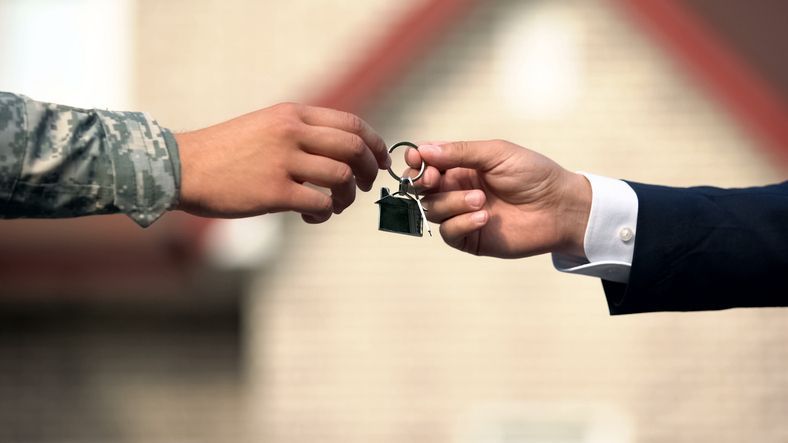
The Veterans Affairs loan program, established to honor American service members and veterans, provides a range of mortgage options designed to make this cornerstone of the American dream more attainable. Whether it’s buying a new home, refinancing an existing mortgage or making home improvements, the VA loan program offers current and former members of the military various pathways. Here’s an overview of the program and what you should know when considering a VA loan.
A financial advisor can help you save for a home purchase or give advice as you consider refinancing. Find a fiduciary advisor today.
What Is a VA Loan?
The VA loan is a mortgage loan program in the United States, guaranteed by the Department of Veterans Affairs (VA). It was created to provide long-term financing to eligible American service members and veterans or their surviving spouses, as long as they do not remarry.
The primary objective of the VA loan is to facilitate homeownership for veterans who might otherwise be unable to afford it due to financial constraints. By offering the opportunity to purchase properties without a down payment, the VA loan serves as a significant benefit, enabling veterans to secure housing without the substantial initial capital typically required in the conventional mortgage market.
Originating from the original GI Bill of Rights in 1944, the VA loan program was a part of the comprehensive package provided to returning World War II veterans. The Department of Veterans Affairs administers the program, which has evolved through numerous amendments and expansions to accommodate a broader range of veterans and to enhance the benefits offered.
Types of VA Loans

VA loans are not a one-size-fits-all solution. Rather, they come in various forms to meet the unique needs of veterans. Before delving into the specifics, it’s important to understand the breadth of options available.
The standard VA purchase loan is the most commonly known, but there are also specialized options such as the Native American Direct Loan (NADL), the Interest Rate Reduction Refinance Loan (IRRRL), the VA cash-out refinance, the VA Energy Efficient Mortgage and the VA Rehab and Renovation Loan.
Each type of VA loan is designed with particular scenarios in mind, whether it’s purchasing a new home, refinancing an existing mortgage, or making home improvements, ensuring that veterans have access to financial support that aligns with their specific circumstances.
- VA purchase loan: Offers eligible veterans the chance to buy a home with no down payment and no requirement for private mortgage insurance. This loan type is particularly attractive due to its competitive interest rates and the VA’s limitation on closing costs, which can significantly reduce the upfront expenses veterans face when purchasing a home.
- Native American Direct Loan (NADL): The NADL program is a specialized initiative that provides direct home loans from the VA to eligible veterans who are Native American or have a Native American spouse. This program facilitates the purchase, construction or improvement of homes on federal trust land.
- VA Interest Rate Reduction Refinance Loan (IRRRL): The IRRRL, commonly referred to as the VA Streamline Refinance, offers veterans with existing VA loans an avenue to reduce their interest rates and monthly mortgage payments. This refinancing option is designed to be straightforward and cost-effective, often not requiring a new appraisal or extensive underwriting.
- VA Cash-Out Refinance: Allows veterans to refinance their non-VA loan into a VA-backed loan and access up to 100% of the equity in their home as cash.
- VA Energy Efficient Mortgage: The VA Energy Efficient Mortgage program allows veterans to finance the cost of energy-efficient home improvements as part of their VA loan. Veterans can add up to $6,000 for qualifying improvements – like solar heating systems, thermal windows or insulation upgrades – without requiring an additional appraisal.
- VA Rehab and Renovation Loan: Enables veterans to finance both the acquisition and the renovation costs through a single mortgage, streamlining the process of turning a fixer-upper into a comfortable and modern living space. Eligible renovations can range from structural modifications to energy efficiency upgrades.
What Is a VA Loan Funding Fee?
The VA loan funding fee is a mandatory one-time payment that borrowers must make when obtaining a VA loan. This fee serves to offset the cost of the loans to U.S. taxpayers, as the VA loan program is a government-backed initiative.
The amount of the funding fee varies based on several factors, including the type of loan, the size of the down payment and whether the borrower has previously used a VA loan. The fee can range from as low as 1.25% of the loan amount to as much as 3.3%, representing a significant cost that must be considered by prospective borrowers.
The structure of the funding fee is tiered, with different percentages applied based on various criteria. For example, a first-time user of a VA purchase loan with no down payment would incur a 2.5% funding fee, while a veteran using the benefit for a second time would pay 3.3% if their down payment was less than 5%.
Here’s a look at the ranges of funding fees for the various VA loan programs:
| Loan Type | Funding Fee Range |
|---|---|
| Purchase Loan | 1.25%-3.3% (first use); 1.25%-3.3% (after first use) |
| Cash-out Refinance | 2.15% (first use); 3.3% after first use |
| NADL | 1.25% (purchase); 0.5% (refinance) |
| IRRRL | 0.5% |
How to Qualify for a VA Loan
To qualify for a VA loan, a borrower will need to fulfill service requirements, including a minimum period of active duty service for veterans or a certain number of years of service for National Guard members and reservists:
- 90 consecutive days of active service during wartime
- 181 days of active service during peacetime
- More than six years in the National Guard or Reserves
- Or being the spouse of a service member who has died in the line of duty or as a result of a service-related disability
Eligibility is not automatically granted – veterans must obtain a Certificate of Eligibility (COE) to prove to lenders that they meet the minimum service requirements. The COE can be requested through the VA’s eBenefits portal, by mail or through a VA-approved lender who can often obtain it more quickly electronically.
In addition to service criteria, applicants may also have to demonstrate a satisfactory credit score and sufficient income to manage their monthly expenses, including the new mortgage payment. While the VA does not enforce a strict credit score requirement, most lenders prefer candidates with a credit score of 620 or higher.
Lastly, VA loans are designated for primary residences only. This means that veterans and active members must intend to occupy the home as their primary residence within a reasonable period after closing.
Pros and Cons of a VA Loan

VA loans offer many advantages for eligible veterans. However, they can also carry some drawbacks. The funding fee, while necessary to sustain the program, can be a substantial upfront cost, although it can be financed into the loan.
Pros of a VA Loan
- No down payment required: VA loans do not require a down payment, removing a major barrier to homeownership for many veterans and active military members.
- No private mortgage insurance (PMI): While PMI is required if the down payment for a conventional mortgage is less than 20%, PMI isn’t required on VA loans. This omission can result in substantial monthly savings for the homeowner.
- Competitive interest rates: VA loans are known for their competitive interest rates, which can be lower than those of conventional loans. These favorable rates are possible because the VA backs a portion of each loan, reducing the lender’s risk.
- Less stringent credit requirements: VA loans are generally more forgiving regarding credit scores and past financial difficulties, such as bankruptcy or foreclosure.
- No prepayment penalty: Borrowers can pay off their VA loan early without facing prepayment penalties. This flexibility could save significant interest over the life of the loan if financial circumstances improve.
Cons of VA Loans
- VA funding fee: While VA loans do not require PMI or a down payment, they do come with a VA funding fee. This fee varies depending on the amount of the down payment and the borrower’s use of the VA loan benefit. It can be financed into the loan amount but increases the overall cost of the mortgage.
- Property restrictions: VA loans come with specific requirements for the properties they can be used to purchase. The home must be the borrower’s primary residence and meet certain safety and livability standards. This restriction can limit investment opportunities and the purchase of vacation homes.
- Longer closing times: The closing process for VA loans can be longer than that for conventional loans. This delay is often due to the added appraisal and documentation requirements set by the VA to ensure the property meets its standards.
- Limited to certain borrowers: VA loans are exclusively available to members of the military community, which includes veterans, active-duty service members, and certain military spouses. This limitation means that many potential borrowers do not qualify for these benefits.
VA Loan Limits
In 2024, veterans and active military members seeking to purchase homes with a VA loan will find that the dynamics of loan limits have changed. Contrary to popular belief, there are no longer fixed VA loan limits that apply universally to all borrowers. Instead, these limits are determined by the individual’s entitlement and the conforming loan limits set by the Federal Housing Finance Agency (FHFA).
Eligible veterans are afforded a basic entitlement and possibly a secondary bonus or an additional entitlement. The basic entitlement guarantees $36,000, which the VA will pay to the lender if the borrower defaults on a loan up to four times that amount (traditionally $144,000). However, lenders typically allow loans up to four times a veteran’s total entitlement without requiring a down payment, provided the veteran has sufficient income, satisfactory credit, and meets other lending criteria.
For veterans with remaining partial entitlement, the loan limits still apply. This situation can occur if a veteran has an active VA loan or has lost part of their entitlement in a foreclosure. The loan limit in such cases will depend on the county in which the property is located, reflecting the FHFA’s conforming loan limits.
2024 Conforming Loan Limits
For 2024, the FHFA has adjusted the conforming loan limits to accommodate the rising home prices. These limits vary by county and are higher in areas with more expensive housing markets. Generally, the baseline limit for a single-family home has seen an increase, allowing veterans using partial entitlement to access higher loan amounts before needing to consider a down payment.
For veterans with full entitlement:
- There is no upper limit to the amount they can borrow without a down payment, subject to lender’s credit and income requirements.
For veterans with partial entitlement:
- The loan limits are tied to the FHFA’s conforming loan limits, which may require a down payment if the loan amount exceeds these limits.
How to Apply for a VA Loan
The application process for a VA loan begins by securing a certificate of eligibility to confirm the veteran’s eligibility. Pre-approval is the next step, where the veteran provides financial information to a lender so that they can determine the loan amount that they qualify for.
With pre-approval in hand, the veteran can then search for a home within their budget and make an offer.
Once accepted, the loan moves into the underwriting phase for finalization. Documentation required during the application process typically includes the COE, proof of income, bank statements and a valid government-issued ID, with additional documents potentially requested based on individual circumstances.
Choosing an experienced VA-approved lender can significantly impact the terms and success of the loan. Veterans should compare rates and fees from multiple lenders to secure the best deal.
The closing process involves a considerable amount of paperwork, payment of closing costs, and a thorough understanding of the loan terms. It is vital for veterans to exercise their right to a final property walk-through before closing and to fully comprehend all aspects of their loan agreement. Upon closing, the veteran assumes homeownership and starts making regular mortgage payments.
Bottom Line
The VA loan program helps to support American service members, veterans and their families, offering diverse mortgage options tailored to their specific needs and circumstances. While the VA loan funding fee and the qualification process may present hurdles, the overarching benefits of the program – such as competitive interest rates, the absence of private mortgage insurance and down payment requirements – can often outweigh the drawbacks for potential borrowers.
Homebuying Tips
- Whether you’re looking to purchase your first home or have owned a number of properties, it’s important not to overextend yourself and buy a home that’s too expensive. To figure out how much house you can afford, SmartAsset built a calculator that can help you get an estimate.
- A financial advisor can help you plan and save for a home purchase. Finding a financial advisor doesn’t have to be hard. SmartAsset’s free tool matches you with up to three vetted financial advisors who serve your area, and you can have a free introductory call with your advisor matches to decide which one you feel is right for you. If you’re ready to find an advisor who can help you achieve your financial goals, get started now.
Photo credit: ©iStock.com/michaeljung, ©iStock.com/Motortion, ©iStock.com/SDI Productions